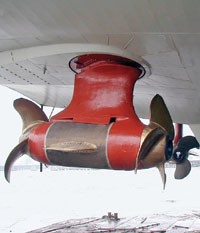 |
Belgium, Germany, Spain |
|
Modern thrusters for the offshore industry
Germany’s SCHOTTEL Gmbh & Co. KG offers 360° azimuthing propulsion and maneuvering systems, as well as conventional propulsion packages up to 30 MW. The systems are particularly suited for vessels and rigs working in oil, gas and other seabed exploration and drilling, as well as for pipe and cable laying, assistance and supply vessels.
As the inventor of the 360° right-angle drive called SCHOTTEL Rudderpropeller (SRP), the company was the first supplier of a steerable Rudderpropeller to the offshore industry. This happened back in 1963, when the company equipped the Terebel, a drilling vessel owned by the Institut Francais du Petrol (IFP), with two SRP 150 units. The vessel was one of the first dynamically positioned unit with steerable thrusters.
Underwater mounting is the most common form of installing Rudderpropellers on large floating structures which cannot be dry-docked, and where the underwater part of a thruster has to be taken onto deck for maintenance/ overhaul. The company has had experience with the underwater mounting of thrusters up to 5,000 kW since 1981. An example is the crane and pipe-laying vessel Saipem 7000, with four Rudderpropellers of type SRP 4500 rated at 5,000 kW each. Further example applications are the ENSCO 7500 semisubmersible drill rig, and the semisubmersible drilling vessel RBS 8M.
 |
Electric Propulsor of type SEP 2 (2.1 MW each) installed on new German research vessel.
|
|
The company’s Twin Propeller (STP) – the optimized efficiency variant of the classic Rudderpropeller – is equipped with two propellers on one shaft rotating in the same direction. The STP is for propulsion and maneuvering system for offshore supply vessels – particularly for vessels operating over long distances. The main advantage of this technology is the fuel saving of over 10%, compared with similarly rated conventional propulsion systems. This is due to the significantly greater efficiency of the STP. Further, it is a fully steerable propulsion unit suitable for all dynamic positioning classes.
Especially for DP purposes, the company’s Pump-Jet (SPJ) is the optimum bow thruster, providing thrust in all directions. The main features are: compact design and, thus, easy installation, minimum displacement loss, installation flush with the hull, virtually no damage risk due to grounding or floating debris, and low-noise operation due to the encapsulated design. Pump-Jet avoids the need to install a complicated retractable thruster.
The technology of the Twin Propeller also served as a model for the Siemens-SCHOTTEL Propulsor (SSP), with power ratings up to 20 MW. This pod drive is designed for sea-going ferries, supply vessels, tankers and container ships, for example, and has proven reliable in RoPax ferries, heavy-lift carriers and tankers.
A “little brother” of this propulsion system is an entirely in-house development. Two SEP 2 units (1,850 kW each) are serving as main propulsion units for the multi-purpose vessel MS Arkona operated as a spillage incident vessel and icebreaker in the Baltic Sea. The vessel, built on behalf of the German Water Board, also has outstanding maneuvering characteristics, thanks to a type SPJ 220 Pump-Jet with a power rating of 1,000 kW in the bow. 
|




